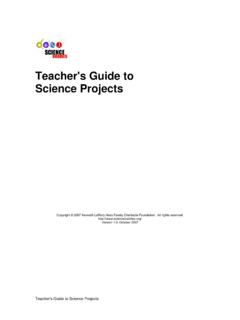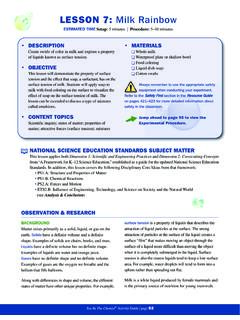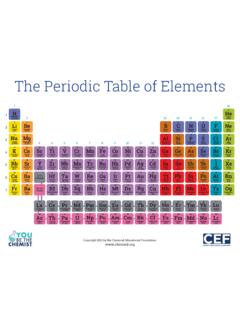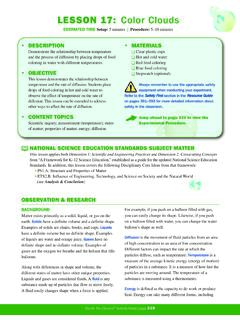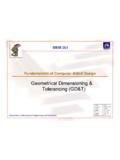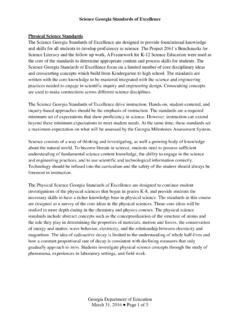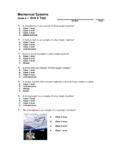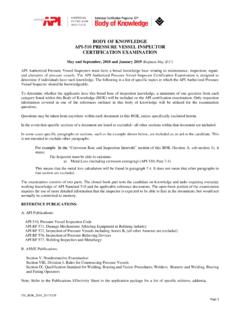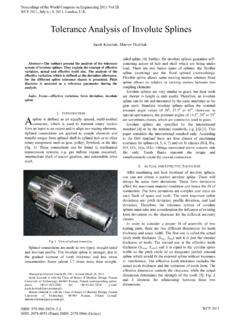Transcription of LESSON 17: Balloon Rockets - chemed.org
1 209 LESSON 1:Goofy Putty209 LESSON 1:Goofy PuttyYou Be The Chemist Activity Guides |page 209 You Be The Chemist Activity Guides |page 209 You Be The Chemist Activity Guides |page 209 You Be The Chemist Activity Guide |page 209 LESSON 17: Balloon RocketsESTIMATED TIMES etup:5 10 minutes|Procedure:5 10 minutes DESCRIPTIONA pply the concepts of pressure and Newton s laws ofmotion to build simple Rockets . OBJECTIVEThis LESSON demonstrates the basic principles ofrocketry by applying the concept of pressure andNewton s Second and Third Laws of Motion. Studentsuse a Balloon to explore these concepts. The LESSON canbe extended to introduce the concepts of drag andpower. CONTENT TOPICSS cientific inquiry, measurement; force (pressure)It is best to use long, thin balloons for thisexperiment. MATERIALSoBalloons oStraws oString oPermanent marker oCargo (paper clips, bottle caps, candy, etc.)
2 OCereal boxes, construction paper, or any othermaterial to make lightweight cargo containers oTape, glue, scissors, and any other materialsneeded for constructionAlways remember to use the appropriate safetyequipment when conducting your to the Safet y Firstsection in the Resou rce Guideon pages 421 423 for more detailed information aboutsafety in the ahead to page 212 to view theExperimental & RESEARCHBACKGROUNDR ocketry has existed for hundreds of years. Although thetechnology has greatly improved and there are numerousmethods for propelling a rocket , the simple sciencebehind Rockets has always been the same. To propel arocket, some kind of force must be expelled from therocket in order to push it forward. A forceis the amountof push or pull on an object. The mechanical force thatpushes a rocket or aircraft through the air is known of Newton s laws of motion relate to force, andtherefore, relate to thrust.
3 Newton s Second Law ofMotionstates that the relationship between an object smass (m), its acceleration (a), and the applied force (F) is F = ma. For example, the force of a basketball pushedtoward the ground is equal to the mass of the ballNATIONAL SCIENCE EDUCATION STANDARDS SUBJECT MATTERThis LESSON applies both Dimension 1: Scientific and Engineering Practicesand Dimension 2: Crosscutting Conceptsfrom A Framework for K 12 Science Education, established as a guide for the updated National Science EducationStandards. In addition, this LESSON covers the following Disciplinary Core Ideas from that framework: : Forces and Motion : Stability and Instability in Physical Systems : Relationship Between Energy and Forces : Definiting and Delimiting an Engineering Problem (see Analysis & Conclusion) : Developing Possible Solutions (see Analysis & Conclusion) : Optimizing the Design Solution (see Analysis & Conclusion) : Interdependence of Science, Engineering, and Technology (see Analysis & Conclusion)You Be The Chemist Activity Guide |page 210 LESSON 17: Balloon Rocketsmultiplied by the acceleration of the ball toward theground.
4 Newton s Third Law of Motionstates that forevery action there is an equal and opposite reaction. For example, when a basketball is pushed toward theground, the force with which the basketball hits theground is oppositely and equally applied back to the ballby the ground. As a result, the ball bounces back upward. In this experiment, the rocket is propelled by the amount of force exerted on an area. Whenyou blow up the Balloon , you are filling the Balloon withgas particles (mainly oxygen). The gas particles movefreely within the Balloon and may collide with one more gas is added to the Balloon , the number of gasparticles in the Balloon increases, as well as the number ofcollisions. While the force of a single gas particle collisionis too small to notice, the total force created by all of thegas particle collisions within the Balloon is significant.
5 As the number of collisions within the Balloon increases,so does the pressure within the addition, the pressure of the gas inside the balloonbecomes greater than the air pressure outside of theballoon. The pressure inside the Balloon serves as the fuelfor the rocket . When you release the opening of theballoon, gas quickly escapes to equalize the pressure insidewith the air pressure outside of the Balloon . As the airescapes from the Balloon , it exerts a force on the groundand the air outside of the Balloon . According to Newton sThird Law of Motion, as the gas is released from theballoon and pushes against the outside air, the outside airpushes back. As a result, the rocket is propelled forward by the opposing force. This opposing force is & EQUATIONSN ewton s laws of motion have played a key role in humans understanding of the universe.
6 Newton s First Law of Motion (the Law of Inertia)states:Every object in a state of uniform motion tendsto remain in that state of motion unless an externalforce is applied to TO THE YOU BE THECHEMISTCHALLENGEFor additional background information, pleasereview CEF s Challenge study materials online Additional information on scientific laws can be found in the Science A Way of Thinkingsection of CEF s Passport to Science Exploration:The Core of Chemistry. Additional information on types of measurements,including force and pressure, can be found in theMeasurement section of CEF s Passport toScience Exploration: The Core of Chemistry. Additional information on states of matter can befound in the in Classification of Matter section ofCEF s Passport to Science Exploration: The Coreof Chemistry.
7 HYPOTHESISuA simple rocket made with a Balloon will be propelled down a string according to Newton s laws of motion, because of thrust generated by pressure. Newton s Second Law of Motions states:The acceleration (a) of an object as produced by a netforce is directly proportional to the magnitude of thenet force (F), in the same direction as the net force,and inversely proportional to the mass (m) of theobject. This relationship is described by the equation:F = ma. Newton s Third Law of Motion states:For every action, there is an equal and opposite is the amount of force exerted on an area. This relationship is described by the following equation:p = Be The Chemist Activity Guide |page 211 LESSON 17: Balloon RocketsLOWER GRADE LEVELS/BEGINNERSC onduct the experiment as described on page 212 (or perform the experiment as a demonstration), andfocus on gases and pressure.
8 How do they know thepressure is increasing in the Balloon ? Use the amount ofpeople in the room as an example. If more people werecrammed into the room and moving around, would theyfeel more pressure on their bodies as they bumped intoone another? Likewise, if you have marbles or similarobjects available, you can instruct students to hold onemarble closed in between both hands. When they shaketheir hands with the marble inside, they will feel themarble move around and collide with the inside of theirhands. If they hold three marbles closed within bothhands and shake them, do they notice a difference?HIGHER GRADE LEVELS/ADVANCED STUDENTSDESCRIPTIONB uild simple Rockets by applying the concepts of pressureand Newton s laws of LESSON demonstrates the basic principles of rocketry,addressing Newton s laws of motion and the concepts offorce, pressure, drag, and & RESEARCH The development of flight and rocketry has led to majoradvances for humans, and these inventions rely on similarprinciples.
9 To propel an aircraft or rocket , some kind offorce must be expelled from the vehicle in order to push itforward. A forceis the amount of push or pull on an object. The mechanical force that pushes a rocket or aircraftthrough the air is known as thrust. On the contrary, dragisa mechanical force that opposes an aircraft s motionthrough the air. It is generated by the difference in velocitybetween a solid object and a fluid(liquid or gas). Withoutthe presence of a fluid or without motion, there is no drag. In this experiment, the rocket is propelled by the amount of force exerted on an area. Whenyou blow up the Balloon , you are filling the Balloon withgas particles (mainly oxygen). The gas particles movefreely within the Balloon and may collide with oneanother. As more gas is added to the Balloon , the number ofgas particles in the Balloon increases, as well as the numberof collisions.
10 While the force of a single gas particlecollision is too small to notice, the total force created by all of the gas particle collisions within the Balloon issignificant. As the number of collisions within the balloonincreases, so does the pressure within the Balloon . In addition, the pressure of the gas inside the balloonbecomes greater than the air pressure outside of theballoon. The pressure inside the Balloon serves as the fuelfor the rocket . When you release the opening of the Balloon ,gas quickly escapes to equalize the pressure inside with theair pressure outside of the Balloon . As the gases escapefrom the Balloon , the gas particles exert a force on theground and the air outside of the Balloon . According toNewton s Third Law of Motion, every action has an equaland opposite reaction. Therefore, as the gas is released fromthe Balloon , it pushes against the outside air, and the outsideair pushes back.
